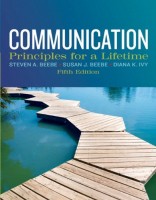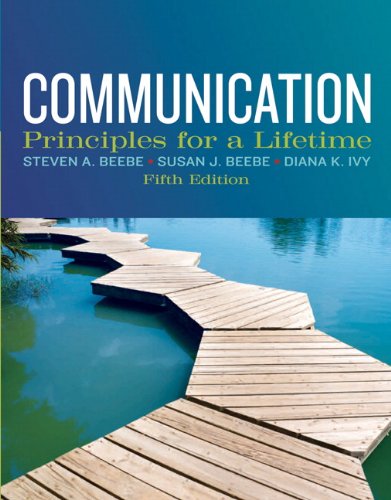 Authors: Steven A. Beebe, Susan J. Beebe, and Diana K. Ivy
Authors: Steven A. Beebe, Susan J. Beebe, and Diana K. Ivy
Publisher: Pearson – 469 pages
Book Review by: Sonu Chandiram
We live in a world with people where communication is not only essential in everyday living, but when done effectively, enhances the quality of our lives. This is the central thesis of this book. Its three authors lay out and discuss the five fundamental principles of communication which they call their “integrated approach” that they point out, has not changed since the first edition of this book was published.
They assert that while these five fundamental principles of communication do not encompass everything you need to know about communication, they are the essence of what you need to know for successful human interaction; moreover they are important principles because they are based on research on what works and what does not work in communication.
So what are these five principles for a lifetime of effective communication? They are:
- Aware – Be aware of your communication with yourself and others
- Verbal – Effectively use and interpret verbal messages
- Nonverbal – Effectively use and interpret nonverbal messages
- Listen and Respond – Listen and respond thoughtfully to others
- Adapt – Appropriately adapt messages to others
Through almost 470 pages and coverage of the many concepts, realities, and nuances in the field of communication, Steven and Susan Beebe and Diana Ivy present a textbook based on a digest of research findings that can help you the student of communication or lay reader, enrich your life. They hope that as you learn, remember, and apply these fundamental communication principles, you will be able to more quickly accomplish the goals in your business or career and to lead an overall happy life.
Instead of going over one by one all the subjects, topics, and subtopics in this book, we present to you here the contents of this book in Units I through IV, its 15 chapters, and a couple of other useful sections in the end:
- Principles of Communication
- Foundations of Human Communication
- Self Awareness and Communication
- Understanding Verbal Messages
- Understanding Nonverbal Messages
- Listening and Responding
- Adapting to Others: Diversity and Communication
- Interpersonal Communication
- Understanding Interpersonal Communication
- Enhancing Relationships
- Communicating in Groups and Teams
- Understanding Group and Team Performance
- Enhancing Group and Team Performance
- Presentational Speaking
- Developing Your Presentation
- Organizing and Outlining Your Presentation
- Delivering Your Presentation
- Speaking to Inform
- Speaking to Persuade
- Interviewing
- Sample Speeches for Discussion and Evaluation
One of the benefits of owning this book is getting access to useful benefits found on this website of Pearson Education: www.MyCommunicationLab.com where you get:
Proven Results: For over 10 years, instructors and students using a MyLab from Pearson have reported better grades through increased engagement and real-time insights into programs.
Engaging Experiences: MyCommunicationLab is designed to reach students in a personal way. Engaging learning and practice opportunities lead to assessment s that create a personalized study plan.
A Trusted Partnership: With millions of students registered annually in a Pearson MyLab, MyCommunicationLab is the most effective and reliable learning solution available in communication. To order this text with MyCommunicationLab use ISBN 0-205-88088-6.
You will find this book easy to use. Each chapter presents a Chapter Outline and Chapter Objects on its first page. In addition, you will find three useful boxed features in the chapters, namely:
- Communication & Diversity
- Communication & Technology
- Communication & Ethics
In chapter 2 entitled Self-Awareness and Communication for example, the Communication & Diversity boxed feature, Self-Concept from East and West, the authors point out Communication scholar Gabriel Bukobza asserts that self-concept in Eastern cultures is based on “malleable, contextual, inconsistent, relational, interdependent, and oriented to group hierarchy,” which is unlike self-concept in Western society that is based primarily on an individual’s own estimation of his or her self worth.
In that same chapter the Communication & Technology feature entitled Got Low Self-Esteem? Get Facebook! points out that a research study found that people who received positive feedback from “friends” enhanced their views of themselves in terms of their physical attractiveness, romantic appeal, and success in maintaining close relationships. It is a fact that some people are not bothered by what others think of them, and their egos are rarely bruised, while others definitely are.
The Communication & Ethics feature in that chapter asks the question Can You Have TOO Much Self-Esteem? in its title itself, and points out that self-help gurus, psychologists, and even parents, in their effort to help low self-esteem children, may have gone too far in building their self-confidence.
Jean Twenge, the lead investigator in a research study on over 16,000 college students and narcissism, found that many who had developed a positive but unrealistically inflated view of themselves and their own power, had become “more miserable than over.” So now psychologists are asking: “how much self-esteem is too much?”
The chapters also contain another feature called Recap that periodically helps you recall, review, and remember the important points covered. An extensive Study Guide is also provided at the end of each chapter that helps you “review, apply, and assess your knowledge and skill.”
All in all this is a highly valuable book by the authors who apply the principles of communication that they teach.
Authors:
Steven A. Beebe – Texas State University, San Marcos
Susan J. Beebe – Texas State University, San Marcos
Diana K. Ivy – Texas A&M University, Corpus Christi







